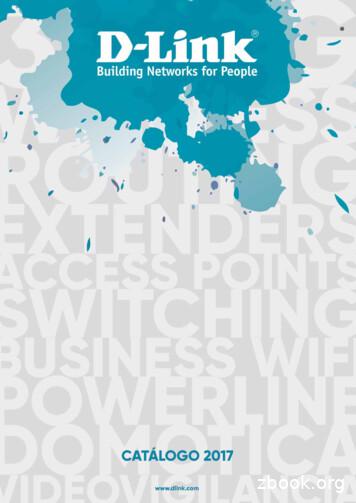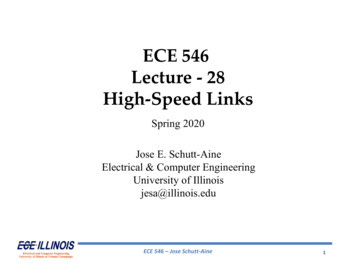112 Gbps Electrical Interfaces An OIF Update On CEI-112G
112 Gbps Electrical Interfaces –An OIF Update on CEI-112GPanel SessionNathan Tracy: OIF President, TE ConnectivityGary Nicholl: OIF Board Member, Cisco SystemsCathy Liu: OIF Board Member, BroadcomMike Li: OIF Board Member, IntelEd Frlan, OIF Technical Committee Chair, SemtechSteve Sekel: OIF Interop Chair, Keysight Technologies
SPEAKERSNathan TracyOIF President/Board Member,TE Connectivity Technologistntracy@te.comCathy LiuOIF Board Member,Broadcom Inc. SerDes Architectcathy.liu@broadcom.comMike LiOIF Board Member,Intel Fellowpeng.mike.li@intel.comCopyright 2020 OIFGary NichollOIF Board Member,Cisco Principal Engineergnicholl@cisco.comEd FrlanOIF Technical Committee Chair,Semtech Senior System Architectefrlan@semtech.comSteve SekelOIF PLL Interop WG chair,Keysight Technologies 400G SolutionsxxSpecialiststeve.sekel@keysight.com2
What is the OIF? Since 1998, OIF has brought together industry groups from the dataand optical worlds Mission: To foster the development and deployment of interoperableproducts and services for data switching and routing using opticalnetworking technologies Our 100 member companies represent the entire industryecosystem: Network operators and network users Component and systems vendors Testing and software companiesCopyright 2020 OIF3
OIF CEI (Common Electrical IO) Electrical ImplementationAgreementsThe Common Electrical IO (CEI) Implementation Agreement (IA) is a clause-based formatsupporting publication of new clauses over time: CEI-1.0: included CEI-6G-SR, CEI-6G-LR, and CEI-11G-SR.CEI-2.0: added CEI-11G-LRCEI-3.0: added CEI-25G-LR, CEI-28G-SRCEI-3.1: added CEI-28G-MR and CEI-28G-VSRCEI-4.0: added CEI-56G-USR-NRZ, CEI-56G-XSR-NRZ, CEI-56G-VSR-PAM4, CEI-56G-MR-PAM4, CEI-56G-LR-PAM4, and CEI-56G-LR-ENRZ.More info at common-electrical-interface-cei-112g-2/Existing document available at /OIF-CEI-04.0.pdf6G11G25G & 28G56G112GSxI-5200020012002CEI-1.0 CEI-2.020032004Copyright 2020 OIF20052006CEI-3.0200720082009201 9
OIF’s CEI Work Has Been a Significant Industry ContributorActivities that Adopted, Adapted or were influencedby the OIF CEIFive channel reach projects in progress, IEEE,InfiniBand, T11 (Fibre Channel), Interlaken, ITU.IEEE, InfiniBand, T11 (Fibre Channel), Interlaken, ITUInfiniBand EDR, 32GFC, SATA 3.2, SAS-4,100GBASE-KR4,CR4, CAUI4, Interlaken, ITUInfiniBand QDR, 10GBASE-KR, 10GFC, 16GFC, SAS-3,RapidIO v3, Interlaken, ITU4GFC, 8GFC, InfiniBand DDR, SATA 3.0, SAS-2, RapidIOv2, HyperTransport 3.1, Interlaken, ITUInterlaken, FC 2G, InfiniBand SDR, XAUI, 10GBASE-KX4,10GBASE-CX4, SATA 2.0, SAS-1, RapidIO v1, ITUNameRate per pairYearCEI-112G112Gbps2021 (projected)CEI-56GCEI-28G56Gbps28 Gbps20172012CEI-11G11 Gbps2008CEI-6G6 Gbps2004SxI53.125 Gbps2002-3SPI4, SFI41.6 Gbps2001-2SPI-4.2, HyperTransport 1.03SPI3, SFI30.800 Gbps2000(from PL3)Copyright 2020 OIF5
OIF CEI-112G Development Application SpaceCEI-112G-MCM3D StackCEI-112G-XSRCEI-112G-VSR2.5D Chip-to-ChipletChip2.5D Chip-to-ChipPluggableOpticsChip to ModuleCEI-112G-MRChipChip-to-Chip & Midplane ApplicationsCEI-112G-LRChipOpticsChip to Nearby Optics EngineChipChipCNRZ-5: up to 25mm package substrateNo equalization/FECMinimize power (pJ/bit)ChipBackplane or Passive Copper CablePAM4: up to 50mm package substrate6-10 dB at 28GHzLite FEC, Rx CTLEPAM4: 12-16 dB at 28GHzFEC to relax BER to 1e-6Multi-tap Tx FIR and Rx CTLE multi-tap FFE or DFEPAM4: 20dB at 28GHzFEC to relax BER to 1e-6Multi-tap Tx FIR and Rx CTLE multi-tap FFE or DFEPAM4: 28-30dB at 28GHzFEC to relax BER to 1e-4Multi-tap Tx FIR and Rx CTLE multi-tap FFE or DFE PAM4 modulation scheme becomes dominant in OIF CEI-112 Gbps interface IA One SerDes core might not be able to cover multiple applications from XSR to LR For short reach applications, simpler and lower power equalizations are desiredCopyright 2020 OIF6
CEI-112GSystem Vendor’s PerspectiveGary Nicholl (gnicholl@cisco.com)Principal Engineer, CiscoOFC 2020, San Jose, March 10-12, 2020
CEI-112G Overview Where do these fit into real systems ? What do they enable ? What are some of the key challengesand takeaways ? Have we learnt anything from ourexperiences at 50G ? 2019 Cisco and/or its affiliates. All rights reserved. Cisco Public8
System ApplicationsFixed (Pizza Box)Two primary system form factors:Modular (Chassis)Fixed (Pizza box): 1RU, 32/36 port, up to 12.8T (today) Single ASIC architecture (typical) Limited flexibility/scalability per boxModular (Chassis): Much larger (up to a full rack) Multiple line card (LC) slots (typically 4-18) Switch Fabric (provide LC-to-LC connectivity) Multi-ASIC architecture Very Scalable 2019 Cisco and/or its affiliates. All rights reserved. Cisco Public9
Fixed Switch (e.g. 25.6T, 32x800G Pluggable)25.6T Fixed Switch Platform (1 RU) 17.5”Fans Power Supplies88RT#1ED0De.g QSFP-DD800CEI-112G-MROptical InterfacesCEI-112G-VSR8SwitchASICED0D8Copper Interfaces(Direct Attach)CEI-112G-LRCEI-112G-MR8RT8#3219-26” 2019 Cisco and/or its affiliates. All rights reserved. Cisco PublicRT Retimer, ED-Electrical Die, OD Optical DieHostConnectorPluggableModules10
Fixed Switch (more forward looking)Fixed Switch Platform (1RU)FaceplateFans Power SuppliesSwitch ASIC PackagePluggable optical roprietary interface ?Co-packaged optical interfacesCEI-112G-MCM/XSR typically used within a package (die-to-die) 2019 Cisco and/or its affiliates. All rights reserved. Cisco PublicRT Retimer, ED-Electrical Die, OD Optical Die11
Modular SwitchModular Switch PlatformLine Cards (LC)Fabric Cards (FC)BackplaneCEI-112G-LR 2019 Cisco and/or its affiliates. All rights reserved. Cisco Public Front (customer) facing half of Line card isidentical to Fixed Switch in terms of electricalinterfaces: CEI-112G-VSR/MR/LR Main difference is the additional links required tointerconnect the Line cards and Fabric cards: CEI-112G-MR/LR12
Clickto editMastertitle on VSR, and LRCEI-112G:StatusUpdatestyleChannelsClick to edit Master subtitle styleNathan Tracy, OIF President and TE Connectivity Technologist
What Happens When We Double The Data Rate?Going from 50 Gbps to 100 Gbps electrical rates brings a host of challenges including noise (cross talk),reflections, mode conversion, etc., but especially insertion loss (reach), because the equipment is the samesize as it was at 50 Gbps.Frequency GHz01020304050600-101m 28AWG Twinax cabledB Loss-20-301m Meg8 PCB-40-501m Meg6 PCB-60-701m FR4 PCB-80As we consider channels for 100 Gbps, we need lower loss architectures14
CEI-112G-VSR-PAM4Interface for chip to module applications with a channel reach of at least 10 cm of host trace, one connectorand 2 cm of module traceDefines compliance test methodologyVSR specifies Tx and Rx parameters at the connector compliance point since host assemblies and modulesare made by different partiesAlternate implementations are allowed15
VSR Channel, Test vs Model Results, Existing 50GbpsConnectorRed Model (56G Connector)Blue Test (56G Connector)Note: Measured channel includes second set of vias to test point,modeled channels do not include the second set of vias.16
100G Connector Improvements (in the same 15dB channel)Efforts were focused on insertionloss and return loss optimizationsImproved 100GbpsOSFP connectorNote: Measured channel includes second set of vias to test point,modeled channels do not include the second set of vias.17Red Model (56G Connector)Blue Test (56G Connector)Pink Model (100G Connector)
CEI-112G-LR-PAM4Interface for backplane applications with a channel reach of 100 cm over 1 or 2 mated connectors andPCB and/or twinax cables.Compliance point will be semiconductor ball.Traditional Backplane ArchitectureOrthogonal Backplane ArchitectureCabled Backplane Architecture18
CEI-112G-LR InterfaceCathy Liu19
CEI-112G-LR - ChannelsCEI-112G-LRChipChipBackplane or Passive Copper CablePAM4: Backplane or Cu cable interfaceIL: Up to 28dB at 28GHzFEC to relax BER to 1e-4 Differentiations between CEI-112G and 802.3ck– CEI covers more interfaces– CEI covers wider range of baud rates– CEI allows low latency and low cost FEC for VSRand XSR interfaces CEI-112G-LR COM and ERL define the channelcompliance– Insertion Loss target: 28dB at Nyquist– ERL specifies channel effective return loss:10.5dB Trade-offs between:––––20 Channel lossBER targetLink ratesPower and cost
CEI-112G-LR – Reference Equalization Latest CEI-112G-LR IA adopts– 5-tap Tx FIR– c(-3), c(-2), c(-1), c(0), and c(1)– CTLE– 2-zero and 3-pole– DFE:––21 Floating tap DFE 12 fixed taps, 3 banks of 3 floating taps with 40UI spanCoefficient constraints bmax(1) 0.85, bmax(2-3) 0.3, bmax(4-12) 0.2,bmax(floating) 0.05, bmin -0.05DFE schemes% passing channels(among green zone)Floating DFE/53G/1e-49716-tap DFE/53G/1e-486.6Floating DFE/56G/1e-487.5Floating DFE/56G/1e-541.3
Mike Peng LiIntel
CEI-112G-XSR-PAM4 Link Requirements
CEI-112G-XSR-PAM4 Channel Requirements10 dB29 GHz
Mike Peng LiIntel
CEI-112G-MR-PAM4 Link Requirements
CEI-112G-MR-PAM4 Channel Requirements20 dB29 GHz
CEI-112G MCM and VSR InterfacesEd Frlansemtech.comPrincipal Product Definition Specialist, Semtech
CEI-112G-MCM OverviewMCM applications based oninterconnected chiplets: Combination of many dies into large packagesNon-interposer MCMscan easily use 20 ormore dies 2.5 cm can accommodate a 70 mm packageImprovement in yield and cost over a monolithic ICEnables multi-vendor ecosystemI/O subsystem dies contain SerDes placed around theperimeter, creating smaller virtual packagesCopyrightsemtech.com Semtech Corporation 2020 All rights reservedCEI-112G-MCM key features: 2.5 cm bump-to-bump (up to 6 dB loss)CNRZ-5 modulationDC coupled pathSilicon to siliconClock forwardedFat-pipe applications (i.e., between logic chips)System raw BER 10-15
CEI-112G-VSR OverviewCEI-112G-VSR key features:112G VSR application: For next-generation higher density pluggablemodules (e.g., those based on 4x 100G or 8x100G electrical interfaces) Still a traditional chip-to-module interconnect withone connectorPluggableOpticsChipChip to ModuleCopyrightsemtech.com Semtech Corporation 2020 All rights reserved 16 dB channel insertion loss at 29 GHz PAM4 modulation with allowable range of36 – 58 GBd System pre-FEC BER 10-6 AC coupled channel with one connector Clocking based on per lane CDR function Receivers required to be self-adaptive andautonomous Acceptable system transmitter performancebased upon reference receiver oscilloscopemeasurements via mated compliance boardsat connector interfaces Reference receiver architecture is CTLE with4-tap DFE
CEI-112G-VSR ChallengesTradeoff between equalizer capability andexpected channel performance Especially important for VSR and XSR types ofinterfaces where transceiver pJ/bit is paramount 112G VSR transceiver efficiencies 3 pJ/bit likely tobe enabled with simple equalization schemes Actual implementations may be Analog or DSPSensitivity of PAM4 modulation to channeldiscontinuities, especially for lower lossinterconnects Short channels exhibit significant sensitivity to presentpackage model discontinuities at the PCB interfaceVSR application space is larger than IEEE802.3ck chip-to-module OIF BER 10-6 (cf. IEEE 802.3ck BER 10-5) OIF baud rate 58 GBd (cf. IEEE baud rate 53.1 GBd)PluggableOpticsChipChip to ModuleCopyrightsemtech.com Semtech Corporation 2020 All rights reservedThese reflections result in significant system penalties
Steve Sekel11 MAR 2020400G Solutions Specialist Keysight Technologies
EVOLUTION ARY FROM CEI -56G BASE Unlike CEI-53G Revolutionary shift from NRZ to PAM4, CEI112G is more Evolutionary Refinements to measurements used in CEI-56G - No major newmeasurements added Assumption that receivers will be implemented with ADCs Margins are much tighter – artifacts which were considered“too small” now need consideration Have we identified them all? - How close will actual measurementsmatch COM simulations? More complex reference receivers112 Gbps Electrical Interfaces - an OIF Update on CEI-112G - Measurement Updates33
“ S M AL L ” AR T I FAC T S N O L O N G E R TO O S M AL L Receiver front end analog distortion and noise ADC sampling clock jitterADCDSP ADC quantization noise Equalizer coefficient quantization effects Actual termination impedance versus nominal Differential skew errors112 Gbps Electrical Interfaces - an OIF Update on CEI-112G - Measurement Updates34
Complete Reference Receiver implementation / optimization in both sampling and RT oscilloscopes Lab measurements with real SerDes outputs Compare with simulation Compare results measured with different instruments (Sampling and Real Time) Compare results measured with different vendors instruments In addition to obtaining repeatability, work will be required to speed measurement acquisition andprocessing to a reasonable level (Measuring true EW-6*EH-6 product for optimization is much too slow!)112 Gbps Electrical Interfaces - an OIF Update on CEI-112G - Measurement Updates35
112 Gbps Electrical Interfaces:An OIF Update On CEI-112GQUESTIONS?36
Mar 12, 2020 · 11G 25G & 28G 56G CEI-3.1 CEI-4.0 112G The Common Electrical IO (CEI)
Fast Ethernet Unmanaged Switches Model DES-1005D DES-105 DES-1005P DES-1008D DES-108 DES-1008PA DES-1016D DES-1018MP DES-1024D Number of Fast Ethernet ports 5 5 5 8 8 8 16 16 24 Number of Gigabit ports 2 Switching capacity 1 Gbps 1 Gbps 1 Gbps 1.6 Gbps 1.6 Gbps 1.6 Gbps 3.2 Gbps 1.6 Gbps 4.8 Gbps PoE standards 802.3af 802.3af 802.3af PoE
Cisco ASA 5585-X with SSP-60 Stateful inspection firewall throughput (maximum)1 4 Gbps 10 Gbps 20 Gbps 40 Gbps Stateful inspection firewall throughput (multiprotocol)2 2 Gbps 5 Gbps 10 Gbps 20 Gbps Concurrent firewall connections 1,000,000 2,000,000 4,000,000 10,000,000 Firew
Stateful inspection firewall throughput (multiprotocol)2 15 Gbps 40 Gbps 30 Gbps 45 Gbps 40 Gbps 50 Gbps 50 Gbps Concurrent firewall connections 10 million 15 million 15 million 25 million 25 million 40 million 35
Fiber type 1 Gbps FC 2 Gbps FC 4 GBPS FC 8 Gbps FC 16 Gbps FC 32 Gbps FC OM3, 50/125 µm 4.62 3.31 2.90 2.28 1.88 1.87 OM4, 50/125 µm 4.62 3.31 3.29 2.26 1.98 1.86 Figure 1: SR4 switch connectivity with MPO parallel fiber infrastructure. 4 SYSTIMAX Application Assurance design guide MPO Equipment Cord MMF Trunk Cable (MPO-MPO) Cabinet 1 .
SonicWall Product Lines Contents SonicWall SuperMassive E10000 series 2 SonicWall SuperMassive 9000 series 3 SonicWall NSA series 4 . SSL Inspection and Decryption (DPI SSL)2 200 Mbps 300 Mbps 500 Mbps 800 Mbps 1.3 Gbps VPN throughput3 1.1 Gbps 1.5 Gbps 3.0 Gbps 4.5 Gbps 5.0 Gbps
ECE 546 –Jose Schutt‐Aine 3 Memory Bus (Single‐ended, Parallel) DDR (4.266 Gbps) LPDDR4 (4.266 Gbps) GDDR (7 Gps) XDR (differential, 4.8 Gbps) Wide IO2, HBM Cable (Differential, Serial) USB (4.266 Gbps) HDMI (4.266 Gbps) Firewire: Cat 5, Cat 5e,
Table 1. Cisco ACE to Avi Networks Cisco CSP 2100 Existing Cisco Model Migration to Cisco CSP Avi Vantage Ace 4710 Throughput: 0.5, 1, 2, 4 Gbps SSL Throughput: 1 Gbps SSL TPS: 7,500 Cisco CSP 4-core Avi SE Throughput: 20 Gbps SSL Throughput: 4 Gbps SSL TPS: 8,000 Ace 30 Service Module Throughput: 4, 8, 16 Gbps
NSA 5600 firewall only 01-SSC-3830 NSA 5600 TotalSecure (1-year) 01-SSC-3833 Firewall NSA 6600 Firewall throughput 12.0 Gbps IPS throughput 4.5 Gbps Anti-malware throughput 3.0 Gbps Full DPI throughput 3.0 Gbps IMIX throughput 3.5 Gbps Maximum DPI connections 500,000 New connections/sec 90,000/sec Description SKU NSA 6600 firewall only 01-SSC-3820























